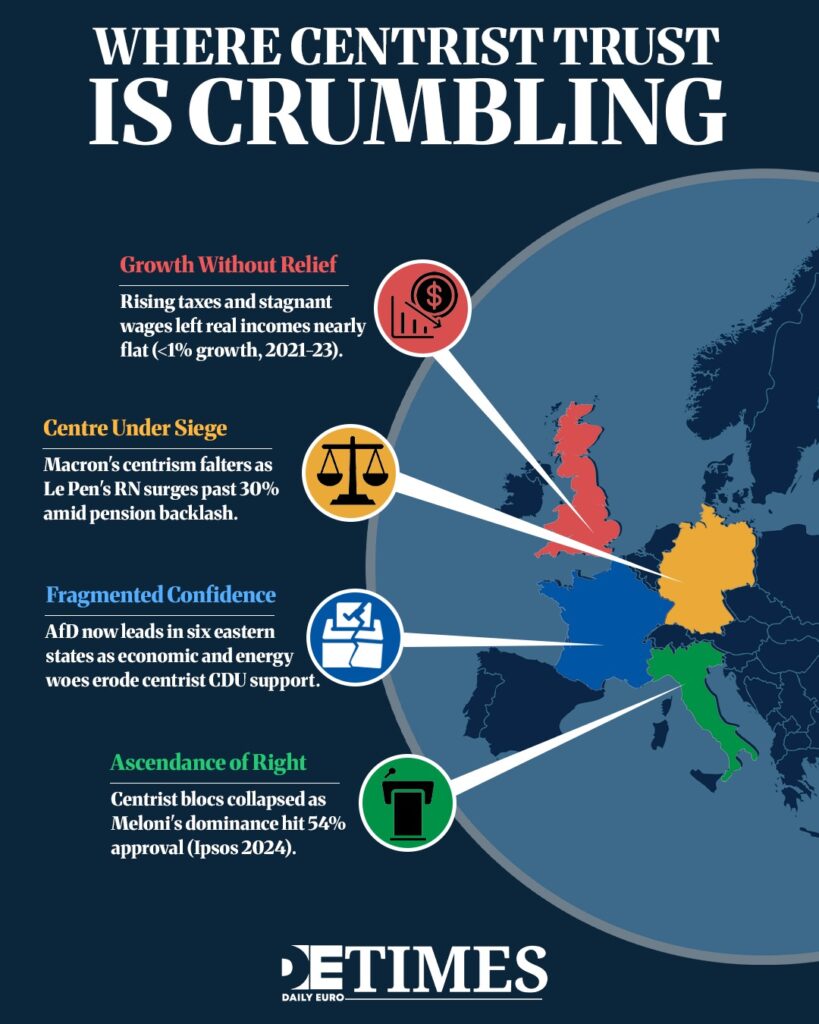The political landscape across Europe and the UK is undergoing a profound transformation. Once trusted by millions, centrist parties are increasingly squeezed between populist insurgents, nationalist movements, and a disillusioned electorate.
Three key forces drive this erosion of the political centre:
- Mass Immigration
- Economic Stagnation
- Rising Tax Pressure.
Mass Immigration and Political Consequences
Immigration is one of the most important issues challenging the traditional roles for the centre-right and centre-left parties.
- The European Union and the United Kingdom have seen an increase in migration flows, including refugees and asylum seekers, over the past few years. This has raised concerns among those who feel that public infrastructure, the labor market, and the social security system are unable to cope with the strain. Centrist parties strive to balance their commitments to human rights, international law, and voter fears, often resulting in either stricter immigration regulations or a loss of trust among migrants and liberal-minded segments of the population.
- In attempting to “leapfrog” far-right parties, centrists often adopt their rhetoric on immigration, which not only dilutes their identity but can also alienate their traditional electorate. For example, research shows that centre-left parties promising strict immigration measures fail to attract significant votes from the right, but risk losing support within their base.
- In many countries, anti-immigration nationalists and populists have crafted a compelling narrative: “migrants are a burden on taxes/social security/infrastructure.” These ideas appeal to groups that feel economic development doesn’t directly affect them or that they are forced to compete for resources. Centrists are often forced to either address these fears or ignore them—both approaches are fraught with consequences.
Economic Stagnation: The UK and the G7
GDP, income, and wealth growth have been uneven in recent years, often less optimistic than expected.
- The UK is a key example: despite growth spurts and post-pandemic recovery, average GDP growth remains weak. According to the Resolution Foundation, GDP per capita is still below it’s late 2019 level.
- Growth rates in the UK and other G7 countries remain low compared to pre-crisis periods. Forecasts from the OECD and other think tanks place the UK near the bottom of the G7 for growth in the coming years, at an average rate of 1-1.5% growth per annum.
- Inflation, particularly following energy and food shocks, has reduced the real income of many households. Wage growth often lags behind price increases, especially when accounting for the tax burden and cost of living. This leads to disillusionment: people feel that while economic indicators are improving (or stabilizing), their personal well-being remains the same or even worsens.
Tax Rising: Pressure and Discontent
Tax increases are a phenomenon that, in the current combination of immigration and stagnation, is becoming particularly painful for the electorate.
- In the UK, tax pressure is rising. One reason is the “frozen” tax thresholds, which means that even without formal rate increases, people pay more due to inflation and automatic promotion to higher tax brackets.
- Furthermore, rising taxes on social services and wages (e.g., national insurance contributions, pension and social system percentages) reinforce the feeling that labor is being burdened with ever-increasing obligations.
Why Centrists Are “Alone”?
The position of centrist parties in Europe today is increasingly precarious due to the confluence of three key factors: immigration, economic stagnation, and rising tax pressure.
Centrists are caught between austerity and liberal principles: by tightening immigration policy, they risk losing the support of progressive segments of society, while by being soft on borders and rigid on fiscal rules… they irritate those who demand change.
Against this backdrop, the contrast with populists becomes especially clear: the latter offer simple and emotionally compelling solutions with rhetoric: "close borders," "lower taxes," "take back control. However, centrists rely on compromise and institutional logic, appearing slow and out of touch.
Even if macroeconomic statistics point to growth, most citizens feel no improvement in their lives, see no increase in income or security, and are therefore losing trust in moderate politicians, preferring more radical voices.

Ample Evidence
- In recent years, many European elections have seen the rise of populist and radical parties, particularly in rural areas and regions where the sense of decline, economic, demographic, or infrastructural, is strongest. According to the study “European Elections 2024,” serious dissatisfaction with the European project and centrist parties is observed precisely in these regions.
- In the UK, trade unions and analysts note that between 2021 and 2023, household income growth barely offset the rise in inflation; consumption growth is extremely weak.
- Research shows that when centrists adopt pro-immigration or nationalist rhetoric, they often end up losing: they lose the trust of their traditional supporters and fail to convincingly win over right-wing supporters.
Possible Centrists’ Strategies
To counter the “loneliness of the middle,” centrists will have to adapt without losing their roots. Here are some areas:
- Honest Communication and Transparency
Explain why resources are limited, what trade-offs must be made, where taxes go, and which investments actually pay off.
- Innovation in the Economy and Productivity Growth
Stagnation is often associated not so much with a lack of potential as with slow technological adoption, poor investment, and weak infrastructure.
Centrists can focus on reforms, increased efficiency, the development of scientific and technological industries, and improved education.
- Immigration Policy Focused on Integration and Quality
Not just “more vs. less,” but smart rules: who to admit and who not, how to integrate, how to avoid social tensions — sociocultural and economic.
- Revising Tax Policy
Simplification, reducing pressure on the middle class, combating tax evasion, increasing the return on taxes by improving the quality of services: healthcare, education, transportation.
With honesty and a commitment to grievances, without the business-as-usual policies, the centrist governments can bring about real change whilst maintaining electoral popularity without conceding ground to populist parties.
Read the Latest Articles on DET!
Airbus’ Edge on Boeing is Innovation, Not Government Support
America First? TikTok Gives Control to Israeli Tech Company
Oktoberfest: A Festival Without the Fest-ivities





